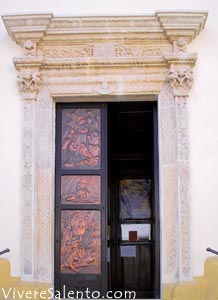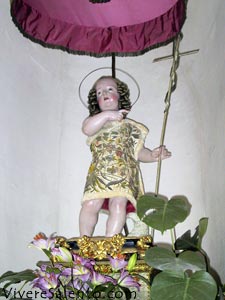|
|

In the historical centre
of Veglie there are the typical case a corte and some interesting noble
palaces to
 see
such as Verrienti Palace and Caccaitore Palace. Cacciatore Palace was built in
'600, and its façade is adorned with elegant windows and a beautiful front
door. Among the religious monuments there is the Mother Church dedicated to St.
John Baptist. It was built in the XVI century on a XV century construction. The
façade has a beautiful Renaissance portal, an enormous rose window and the
sculptures of St. Peter, St. Paul and of the Madonna. Inside there are elegant
altars and some canvasses representing holy images. The Convent of the Minor
Conventual Friars, was built in 1579, on a XV century building. Now nobody
lives in this convent, so it is not in good conditions. This building includes
the Church of St Maria of Veglie where you can admire a Byzantine fresco,
representing the Madonna. The most important monument, historically and
artistically, is the Crypt of the Favana, that is near the convent. Probably it
dates back to the IX century, and it was used to celebrate both the Greek rite
and the Latin one. There are a lot of ancient frescos representing St. John,
the Madonna with the Child, St. Francis, St Andrew St Anthony and St Stephen.
The Church of St Maria of the Graces dates back to the XVIII century and it is
very simple. Outside the urban centre you can see the Church of St Maria from
Constantinople. The façade mirrors the simplicity of the inside, that is of
octagonal-shaped. In the territory of Veglie there are some subterranean
oil-presses dug in the rock. Recently another one has been discovered (XVI
century) . The patron of Veglie is St. John Baptist, that is celebrated solemnly
on the second Sunday of August. see
such as Verrienti Palace and Caccaitore Palace. Cacciatore Palace was built in
'600, and its façade is adorned with elegant windows and a beautiful front
door. Among the religious monuments there is the Mother Church dedicated to St.
John Baptist. It was built in the XVI century on a XV century construction. The
façade has a beautiful Renaissance portal, an enormous rose window and the
sculptures of St. Peter, St. Paul and of the Madonna. Inside there are elegant
altars and some canvasses representing holy images. The Convent of the Minor
Conventual Friars, was built in 1579, on a XV century building. Now nobody
lives in this convent, so it is not in good conditions. This building includes
the Church of St Maria of Veglie where you can admire a Byzantine fresco,
representing the Madonna. The most important monument, historically and
artistically, is the Crypt of the Favana, that is near the convent. Probably it
dates back to the IX century, and it was used to celebrate both the Greek rite
and the Latin one. There are a lot of ancient frescos representing St. John,
the Madonna with the Child, St. Francis, St Andrew St Anthony and St Stephen.
The Church of St Maria of the Graces dates back to the XVIII century and it is
very simple. Outside the urban centre you can see the Church of St Maria from
Constantinople. The façade mirrors the simplicity of the inside, that is of
octagonal-shaped. In the territory of Veglie there are some subterranean
oil-presses dug in the rock. Recently another one has been discovered (XVI
century) . The patron of Veglie is St. John Baptist, that is celebrated solemnly
on the second Sunday of August.

The nickname of the
inhabitants of Veglie is "gypsies." They are so called because in the past a
group of gypsies settled in this small centre. What is more the traders in livestock of
Veglie used to be called "gypsies" too . Since the people of this centre were
very good as merchants they inherited this strange nickname.
gypsies settled in this small centre. What is more the traders in livestock of
Veglie used to be called "gypsies" too . Since the people of this centre were
very good as merchants they inherited this strange nickname.
|